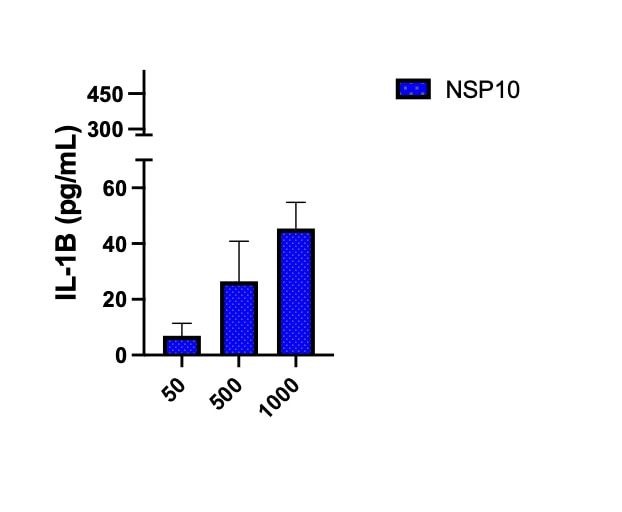Recombinant SARS-CoV-2 NSP10 His-tag Protein, CF Summary
Product Specifications
Ala1-Gln139
with a C-terminal 6-His tag
Analysis
Product Datasheets
Carrier Free
CF stands for Carrier Free (CF). We typically add Bovine Serum Albumin (BSA) as a carrier protein to our recombinant proteins. Adding a carrier protein enhances protein stability, increases shelf-life, and allows the recombinant protein to be stored at a more dilute concentration. The carrier free version does not contain BSA.
In general, we advise purchasing the recombinant protein with BSA for use in cell or tissue culture, or as an ELISA standard. In contrast, the carrier free protein is recommended for applications, in which the presence of BSA could interfere.
10630-CV
| Formulation | Supplied as a 0.2 μm filtered solution in HEPES and NaCl. |
| Shipping | The product is shipped with polar packs. Upon receipt, store it immediately at the temperature recommended below. |
| Stability & Storage: | Use a manual defrost freezer and avoid repeated freeze-thaw cycles.
|
Scientific Data
 View Larger
View Larger
2 μg/lane of Recombinant SARS-CoV-2 NSP10 His-tag (Catalog # 10630-CV) was resolved with SDS-PAGE under reducing (R) and non-reducing (NR) conditions and visualized by Coomassie® Blue staining, showing a band at 16 kDa under reducing conditions.
Reconstitution Calculator
Background: NSP10
Non-structural protein 10 (NSP10), is one of several functional proteins released by ORF1a-encoded protease cleavage of the pp1a and pp1ab replicase polyproteins expressed from the coronavirus (CoV) genome (1). The NSPs are involved in the replication and transcription of the viral RNA and not incorporated within the virion particles. Coronaviruses include various highly pathogenic strains such as SARS-CoV, MERS-CoV and SARS-CoV2 that have had significant impact on humans as well as strains that have negatively impacted livestock. NSP10 is a small 139 amino acid protein that forms independent dodecameric structures composed of four identical trimers where each monomer is capable of binding two zinc ions (2, 3) that are coordinated uniquely and has exposed basic residues on the protein's surface consequently allowing RNA-binding (3). The NSP10 sequence is conserved across coronaviruses (4) and is thought to serve as an important multifunctional cofactor in viral replication. NSP10 was shown to interact with other NSP proteins including NSP14 and NSP16 (5). The N-terminus of NSP10 has been shown to interact with NSP14 and proposed to stabilize and regulate the 3'-5' exoribonuclease domain activity while not directly impacting the methyltransferase activity of NSP14 (6,7). A similar region of NSP10 interacts with NSP16; this interaction is required for stabilization of NSP16 and stimulation of its 2'-O-methyltransferase activity (4,7). Consequently, NSP10 is critically involved in the formation of functional viral mRNA capping machinery in coronaviruses and a potential target to reduce viral replication and pathogenesis (8,9).
- Snijder, E.J. et al. (2016) Adv. Virus Res. 96:59.
- Matthes, N. et al. (2006) FEBS Lett. 580:4143.
- Su, D. et al. (2006) J. Virol. 80:7902.
- Rosas-Lemus, M. et al. (2020) bioRxiv. In press.
- Pan, J. et al. (2008) PLoS One 3:e3299.
- Bouvet, M. et al. (2012) Proc. Natl. Acad. Sci. U.S.A. 109:9372.
- Bouvet, M. et al. (2014) J. Biol. Chem. 289:25783.
- Ma, Y. et al. (2015) Proc. Natl. Acad. Sci. 112:9436.
- Wang, Y. et al. (2015) J. Virol. 89:8416.
FAQs
No product specific FAQs exist for this product, however you may
View all Proteins and Enzyme FAQsReviews for Recombinant SARS-CoV-2 NSP10 His-tag Protein, CF
Average Rating: 5 (Based on 1 Review)
Have you used Recombinant SARS-CoV-2 NSP10 His-tag Protein, CF?
Submit a review and receive an Amazon gift card.
$25/€18/£15/$25CAN/¥75 Yuan/¥2500 Yen for a review with an image
$10/€7/£6/$10 CAD/¥70 Yuan/¥1110 Yen for a review without an image
Filter by:

